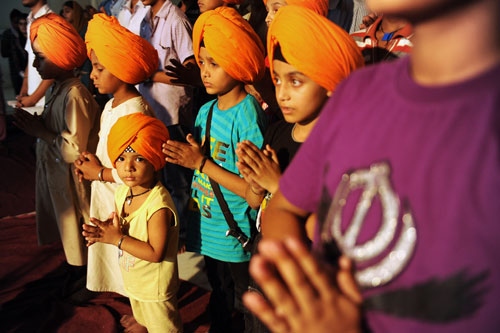The evening turban-tying class in the Sikh-dominated Indian city of Amritsar is packed with pre-teen boys learning the centuries-old tradition that religious leaders fear is under threat

Over the 90 minutes, the instructors unfurl long strips ofcloth in vibrant hues from indigo to burgundy, and proceed to knot, pleat andfinally tie them carefully around the boys' heads. The most visible symbol ofSikh pride and identity, the turban is an eight-metre piece of cloth, used bySikh men to manage the long hair which their religion forbids them fromcutting.
But in India, young Sikh men are increasinglyputting fashion before tradition - cutting their hair short andshunning the turban completely. It has also been abandoned by many members ofthe sizeable Sikh diaspora in countries like the United States, where Sikhshave been attacked over the mistaken belief that the turban marks them asMuslim extremists.
Sikh boys are expected to tie and wear the turban by thetime they reach adolescence, and 12-year-old Upneet Singh began attending the"turban clinic", as the classes in Amritsar are popularly known,about two weeks ago. "I go to a religious school where the turban iscompulsory at my age, so I come here to learn how to tie it," he says. Forreligious leaders such as Avtar Singh, president of the trust that runsSikhdom's holiest shrine, the Golden Temple in Amritsar, forsaking the turbanis tantamount to a rejection of the Sikh way of life.
"The turban is the Sikh identity, it is a sign of ourself-respect, our pride," the bearded 71-year-old stated at his officesnear the temple. No Sikh is complete without his turban," insisted Singh,who blames increasing exposure to western influences for undermining religioustraditions among India's 20 million-plus Sikhs.
Jaswinder Singh, who was 15 at the time of the riots thatmarred the Sikh community after Indira Gandhi was assassinated, said theexperience was a personal turning point that reinforced his faith. "Somany Sikhs died when I was young, it made me realise that I wanted to grow upand do something for my faith, for my community," he said. In 1997, whenhe began to notice young Sikhs frequenting hair salons, he knew he had foundhis cause, and in 2003 the Amritsar-based advocate established his "turbanpride" movement, including regular tying clinics.
Singh also organises turban-tying competitions,turban-themed poetry readings, and a beauty contest called "Mr SinghInternational" open only to Sikhs who don the headgear. In a bid to ensurethat the boys do not shed the headgear for more exciting options as they getolder, Singh has developed a computer programme -- Smart Turban 1.0 -- whichshowcases 60 different ways to tie a turban. "If a Sikh youth loses theturban today, then maybe tomorrow he will abandon the religion all together,that is what I am afraid of," he said."That's why we need to save theturban. This is not just about the turban, it is about what it means to be aSikh.